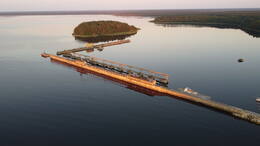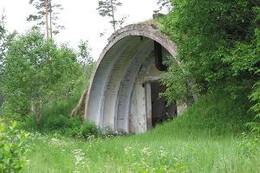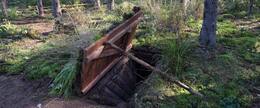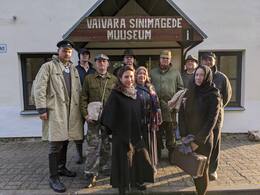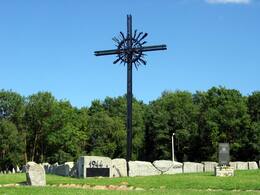Sovietų kariuomenė okupuotoje Estijos teritorijoje
Haros uosto povandeninių laivų bazė
Haros uostas yra to paties pavadinimo kaime Harju apskrityje.
Haros salos pakrantėje buvo pasienio apsaugos postas, kuris buvo naudojamas tiek imperijos laikais, tiek nepriklausomybės laikais iki Antrojo pasaulinio karo. Estijos okupacijos metu postą perėmė sovietų pasienio apsauga. Netoliese buvo pastatytas karinis uostas – istorinė Haros povandeninių laivų bazė arba išmagnetinimo stotis. Demagnetizavimas buvo atliekamas naudojant povandeninius techninius įrenginius ir leido laivų bei povandeninių laivų korpusams atremti magnetines minas.
Visa uosto teritorija anksčiau buvo saugoma zona. Šiuo metu uoste įsikūręs lankytojų centras ir jis naudojamas kaip prieplauka. Vietoje galima susipažinti su bazės istorija, lankytojai taip pat gali apžiūrėti krantinę ir griuvėsius.
Kadilos ir Rohu raketų bazės
Ši raketų bazė yra maždaug už 10 km nuo mažo Maže Marjos miestelio.
Ji buvo Rakverėje sovietmečiu įkurtos branduolinių raketų bazės dalis. Bazė buvo valdoma iš Rakverės septintajame ir aštuntajame dešimtmečiuose. Ji buvo uždaryta 1978 m., nes buvo nusidėvėjusi.
Tai, kas iki šiol liko, daugiausia griuvėsiai. Kai kurie raketų, techninės priežiūros ir sandėliavimo angarai bei nusileidimo aikštelės vis dar nepaliestos.
Miško brolių bunkeris Lebavere
2020 m. Lebaverės miške vėl atidarytas miško brolių bunkeris. Bunkeris buvo sukurtas 1944–1954 m. pagal vieno iš miške besislapsčiusio miško brolio Martino Tamme bunkerių modelį, remiantis jo brolio Kaljo Tamme prisiminimais. Martinas Tammas tokiame bunkeryje gyveno paskutinius šešerius metus miške. 2001 m. Väike-Maarja parapija lankytojams pastatė bunkerį, kuris dabar buvo pasenęs. Vadovaujant Väike-Maarja muziejaus draugų draugijai, miške buvo atkurtas tas pats bunkeris ir atminimo lenta.
Informacijos ir miško brolių bunkerio aplankymo kreipkitės į Väike-Maarja muziejaus draugų draugiją su gidu. Bunkerio lankymas su gidu yra mokamas.
Vaivaros Mėlynųjų kalnų muziejus ir mūšio lauko memorialas
Šis muziejus įsikūręs restauruotame Vaivaros dvaro tvarte, nedideliame Sinimäe miestelyje.
Parodoje pristatomas 1944 m. Antrojo pasaulinio karo Narvos upės ir Mėlynųjų kalvų mūšis. Joje eksponuojami šaunamieji ginklai, uniformos, kareivių asmeniniai daiktai, karo laikų nuotraukos, abiejų pusių propagandiniai plakatai ir kita. Dideliame ekrane rodomi istoriniai filmai ir dokumentiniai filmai. Nors karo tema kai kuriems gali būti sunki, paroda skirta visoms amžiaus grupėms: tėvai gali sutelkti dėmesį į istoriją ir detales, o vaikai gali bendrauti su eksponuojamais eksponatais. Netoli muziejaus yra istoriniai mūšio frontai (3-ioji Sankt Peterburgo gynybinė linija ir Vokietijos rytinės sienos gynybinė linija, žinoma kaip Tanenbergo linija).
Mėlynųjų kalvų mūšio memorialas
Šis memorialas yra Grenaderimägi kalvos vakariniame šlaite Mėlynuosiuose kalnuose, netoli senųjų Vaivaros kapinių.
Tai simbolizuoja Antrojo pasaulinio karo metu Mėlynuosiuose kalnuose vykusį mūšį tarp sovietų ir vokiečių pajėgų.
Pirmasis paminklas Mėlynųjų kalvų rajone – 6,5 metro aukščio medinis kryžius – čia buvo pastatytas 1994 m. Dabartinis memorialas buvo baigtas statyti 2000 m. 12 metrų aukščio plieninį kryžių, kurio bokštas siekia hektarą žemės, sukūrė menininkas ir kalvis H. Mülleris. Kryžiaus viduryje yra sprogimą vaizduojanti kompozicija. 2004 m. prie memorialo buvo pridėtas paminklas 20-ajai Waffen Grenadierių divizijai pagerbti. Po dvejų metų buvo pridėti paminklai olandų ir valonų savanoriams, kovojusiems kartu su estais.
Grenaderimägi kalnas reguliariai keitėsi per vieną mūšį. Paskutinis gynybos taškas, vadinamas „Pragaro skyle“, buvo maždaug už 100 metrų į rytus nuo memorialinio kryžiaus.




